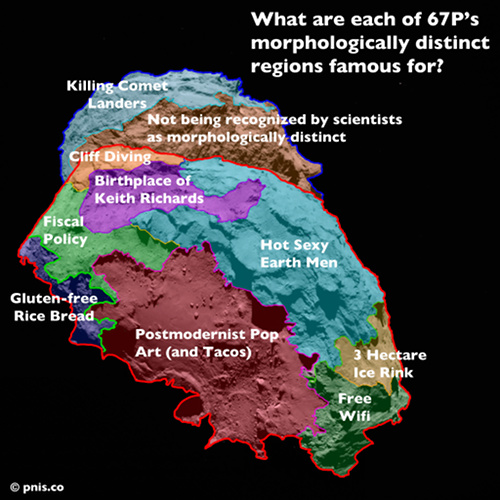
Tweet
November 25, 2014
Proceedings of the Natural Institute of Science | Volume 1 | SOFD 8
Characterizing the morphologically distinct regions of comet 67P/Churyumov-Gerasimenko
L. P. Prince1
1 - Rose College, Sahara Desert

Introduction
On 2 March 2004, the European Space Agency (ESA) launched the Rosetta space probe with the objective to study Comet 67P/Churyumov-Gerasimenko (67P). Just over ten years later on 6 August 2014, Rosetta finally caught up to 67P, and on 12 November deployed a robotic lander named Philae, whose mission was to gather data on the structural composition of the comet. Unfortunately, after harpoon and thruster failure and a series of unfavorable bounces, Philae ended up sideways in a shaded section of the comet with insufficient sunlight to charge its solar cells (although there is hope that 67P’s upcoming journey near the sun will provide enough sunlight to reboot Philae). A seven-person rescue team spearheaded by Tom Hanks is expected to be announced shortly (Saving Lander Philae ©®™).
Despite Philae’s struggles, the mission has already provided some important clues about comets: the ice on 67P is harder than originally thought, there are organic molecules on 67P (DLR 2014), 67P’s surface is surprisingly unreflective, its coma (~ atmosphere) contains oxygen and hydrogen (Brown et al. 2014), and comets sing (manifested as oscillations in the magnetic field around the comet; Fessenden 2014, Heinz 2014). Data from Philae and Rosetta continue to be analyzed by scientists and it is expected that much more data will be collected when 67P begins to warm up and release gas as it approaches the sun.
Images of 67P provided by Rosetta also allowed scientists to map out 9 morhpologically distinct regions characterized by the presence of cliffs, craters and boulders (emily 2014). This finding was particularly ground-breaking because it allowed Rosetta/Philae to make a viral map of Comet 67P similar to the viral maps of the United States, like this one which shows what each US state is worst at. In the case of Comet 67P, Rosetta was fitted with a sensor called STUPID (Sensor That Uploads Pseudoscientific and Irrelevant Delineation), which was able to ascertain what each of the 9 morphologically distinct regions is most famous for. Due to the tremendous importance of this characterization, the ESA decided to fast-track this particular piece of information, making this paper the first to be published using data collected by the Rosetta mission.
Like all viral maps, we have presented the information in a cool map (Fig. 1).


Proceedings of the Natural Institute of Science (PNIS) by https://instsci.org/ is licensed under a Creative Commons Attribution-ShareAlike 4.0 International License.